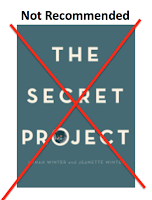Going through her Book-A-Day Almanac with that conviction in mind, I'm a bit puzzled. On one hand, or rather, on one day, she hails Morning Girl by Michael Dorris for helping her to see Christopher Columbus in a new way... Indeed, she was so moved by Morning Girl that she no longer celebrates Columbus Day. Here's what Silvey wrote:
Morning Girl provides a different lens for history. As the saying goes, history gets written by the winners. But in this slim book, Michael Dorris makes it possible to view events in 1492 from the point of view of the people already living in the Americas, sailing no oceans. Because Dorris accomplished his mission so brilliantly, I have not celebrated Columbus Day since I read this small gem.Though I've not written (yet) about Morning Girl on AICL, I agree with her assessment. It is a gem. Reading comments from her readers, I think she influenced several people to revisit how they view Columbus Day, too. That's a good thing because U.S. history is too-often romanticized and glorified, and too-often, stereotypes are not challenged. Dorris challenged these stereotypes, as Silvey tells us:
As a child, Dorris had found only stereotypical Indians in books; so he set out to craft a story with authentic Native American characters that children would want to read about, get to know, and grow to love.What she does not tell her readers is that the stereotypical Indians Dorris found in books he read as a child are the ones in Laura Ingalls Wilder's Little House on the Prairie series---which is that 'other hand' I alluded to above. On one hand, Silvey praises Dorris, and on the other, she praises Wilder. (For my response to Silvey's recommendation of the series, see my post on July 11, 2011.)
In his essay, "Trusting the Words," Dorris wrote about sitting down to read Little House in the Big Woods to his daughters:
Not one page into Little House in the Big Woods, I heard my voice saying, "As far as a man could go to the north in a day, or a week or a whole month, there was nothing but woods. There were no houses. There were no roads. There were no people. There were only trees and the wild animals who had their homes among them."Dorris closed Little House in the Big Woods at that point, deciding he'd set that book aside and try again the next night with Little House on the Prairie. In that one, he recalled that the family had moved west. There, he figured, there would be Indians. Things seemed to be going fine as he read it to his daughters, but then he got to page 46 where Ma tells Laura she doesn't like Indians. Dorris writes:
Say what? Excuse me, but weren't we forgetting the Chippewa branch of my daughters' immediate ancestry, not to mention the thousands of resident Menominees, Potawatomis, Sauks, Foxes, Winnebagos, and Ottawas who inhabited mid-nineteenth-century Wisconsin, as they had for many hundreds of years? Exactly upon whose indigenous land was Grandma and Grandpa's cozy house constructed? Had they paid for the bountiful property, teeming with wild game and fish? This fun-filled world of extended Ingallses was curiously empty, a pristine wilderness in which only white folks toiled and cavorted, ate and harvested, celebrated and were kind to each other.
My dilemma, as a raconteur, was clear. My little girls looked up to me with trusting eyes, eager to hear me continue with the first of these books I had promised with such anticipation. I had made "an event" out of their reading, an intergenerational gift, and now in the cold light of an adult perspective I realized that I was, in my reluctance to dilute the pleasure of a good story with the sober stuff of history, in the process of perpetuating a Eurocentric attitude that was still very much alive. One had only to peruse newspaper accounts of contemporary Wisconsin controversies over tribal fishing rights, bingo emporia, and legal and tax jurisdiction to realize that many of Grandpa and Grandma's descendants remained determined that there could be "no people" except those who were just like them. (p. 271-272)
What was a responsible father to do? Stop the narrative, explain that Ma was a know-nothing racist? Describe the bitter injustice of unilateral treaty abridgment? Break into a chorus of "Oklahoma!" and then point out how American popular culture has long covered up the shame of the Dawes Act by glossing it over with Sooner folklore? (p 274)What he did instead, was start editing and leaving out words and passages as he read, doing what he could to counter the racism until he couldn't do it any longer. There was too much of it. He ended up putting the books on a top shelf and telling them to read them later on, on their own. He closes that essay by imagining a moment sometime in the future when each of his daughters would come to him with the book in-hand, outraged at its contents.
With someone as influential as Anita Silvey recommending the books, she is making sure the books stay on the bedside table, not the top shelf. So you see why I am puzzled by her conviction and the books she writes about on Book-A-Day. How are the stereotypes in the Little House books "the very best" for children? Or the ones in other books she recommends, like Danny and the Dinosaur?
-----
"Trusting the Words" is available in Paper Trails: Essays, by Michael Dorris, published in 1994 by HarperCollins.










